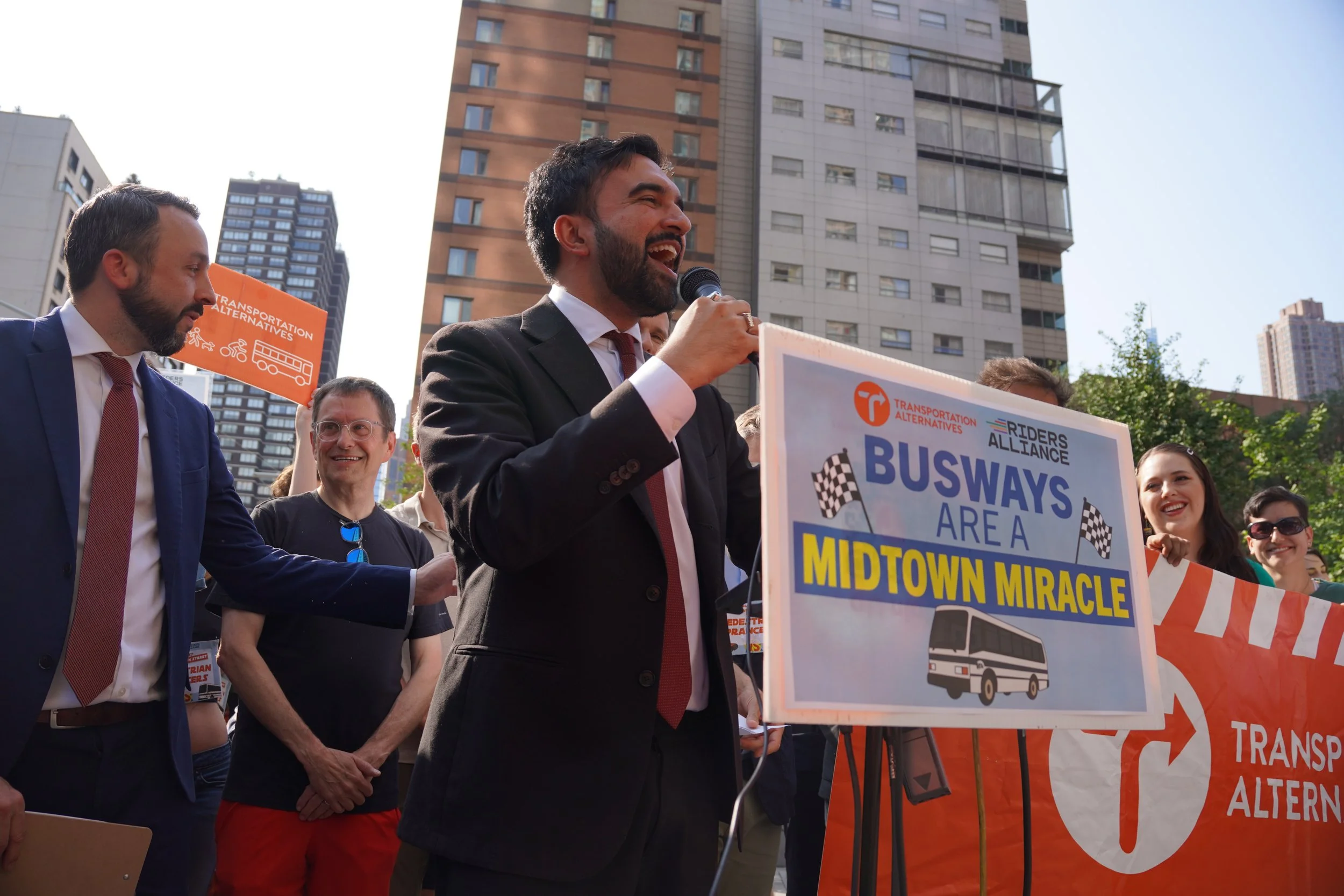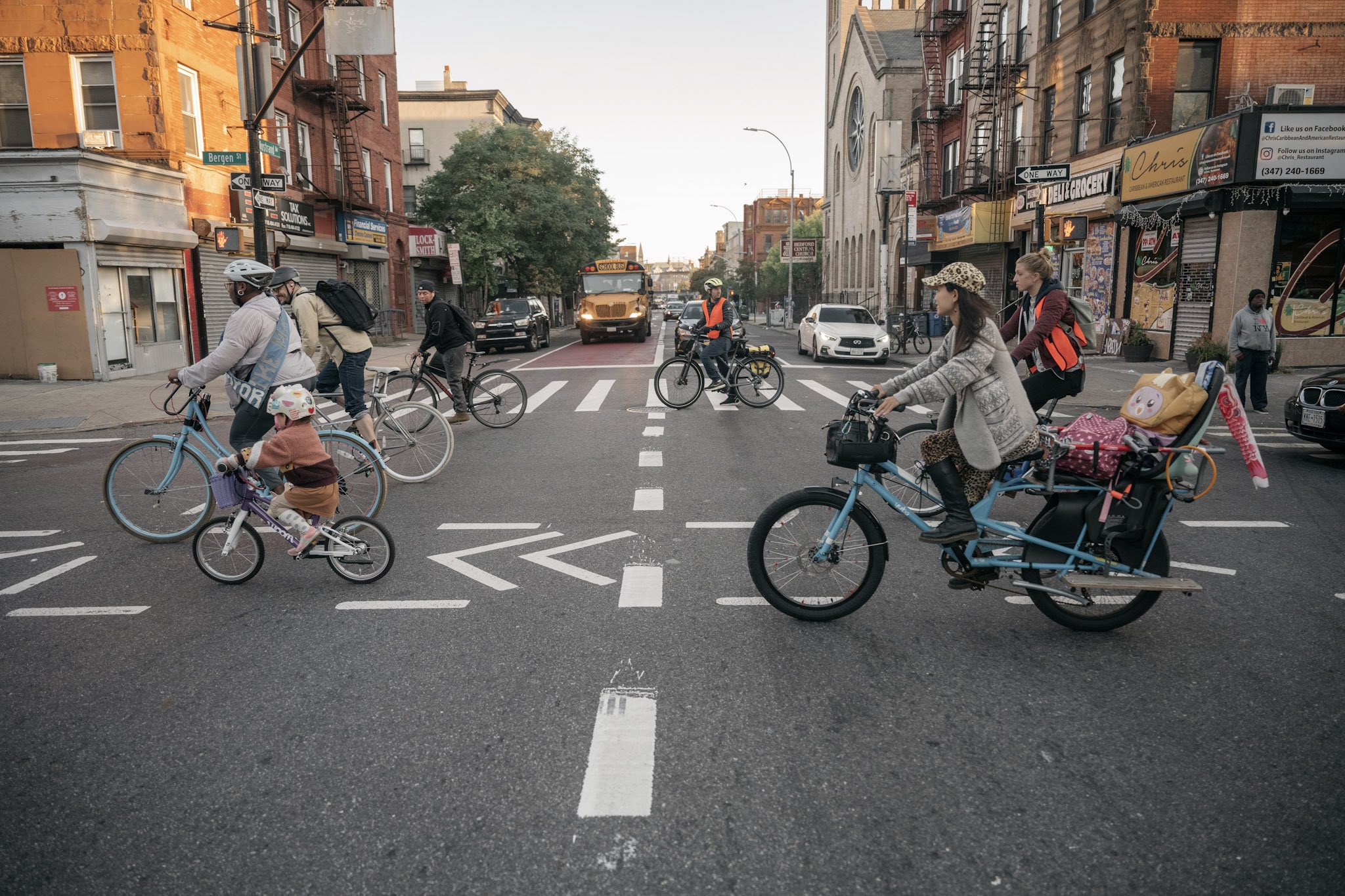Reports
Original research is the backbone of every Transportation Alternatives advocacy campaign. These reports introduce innovative new street designs, import best practices from around the world, and most importantly, hold New York City decision-makers to the highest standard of efficacy.
The New Bicycle Blueprint: A Plan to Make New York a World-Class Bicycling City
A guide to learn how infrastructure upgrades, like daylighting, can transform public spaces to prioritize safety and people.
NASA and Transportation Alternatives reveal the 100 spots where New Yorkers swelter waiting for the bus.
By examining how New York City devotes the majority of its public space to cars rather than people, TA reveals profound inequities built into the streetscape.
A Regulatory Framework to Rein in the Destructive Practices of Same-Day Delivery App Companies for Calm Streets and Just Working Conditions
A Look at the Successes and Shortcomings of America’s First Vision Zero Program
Plus: 15 Quick and Easy Policy Ideas to Demand Right Now
New and more aggressive efforts are needed to protect the four million children who call New York City home.
Why Vehicle Registration Fees Must Be Adjusted to Take into Account Traffic Violence and Road Damage
How to encourage the safe and sustainable growth of e-bikes and other lightweight electric vehicles on New York City streets
By converting car space into space for people, Governor Hochul and the New York State Legislature can dramatically improve public health.
Transportation Alternatives and the Civic Data Design Lab at the Norman B. Leventhal Center for Advanced Urbanism at the Massachusetts Institute of Technology have uncovered alarming inequities in how public space is distributed.
New York City’s automated speed safety camera program, which operates to protect all New Yorkers around city schools, saves lives by reducing traffic crashes and reckless driving. However, by state law, the cameras are restricted from operating on nights and weekends.
While the causes of the crisis are many, one solution could quickly and easily make streets safer: granting home rule over traffic safety to the City of New York and ending Albany’s control over New York City’s streets.
There is a known-solution to inequitable, ineffective, and unsafe streets: redesigning those streets with changes that prioritize moving people over cars. What follows are five site studies that demonstrate what is possible when community-driven planning is catalyzed by technology.
Seven Steps adds practical and specific policy proposals to the NYC 25x25 vision, marking seven waypoints on the road to converting 25% of car space into space for people by 2025.
New York City’s next leaders must turn Open Streets into permanent, 24/7 fixtures of the streetscape, as part of an effort to convert 25% of car space into space for people by 2025.
We need immediate action to reverse the rising death toll on our streets. Passing Sammy’s Law would give the City of New York the power to set its own speed limits and create streets safe for all New Yorkers.
We analyzed the current state of bicycle parking in New York City and its potential to encourage increased cycling, prevent traffic crashes, and reduce the barriers for communities, especially low-income communities and communities of color, to choose cycling.
Older Reports
2017
Bike NYC 2020 (November 2017)
Transportation and Equity: A 2017 Agenda for Candidates (August 2017)
2017 Transportation Issues Poll for NYC (July 2017)
2016-17 Transportation Issues Poll – New York City Speed Safety Cameras in School Zones (July 2017)
School Zone / Speed Zone (June 2017)
Mind the Gap (January 2017)
2016
The Vision Zero Street Design Standard (December 2016)
Atlantic Avenue’s Inequitable Crash Burden (December 2016)
Death, Danger, and Ignoring the Data: How the NYPD is Getting Vision Zero Wrong (July 2016)
The North Shore Transportation Improvement Strategy and Western Richmond Terrace: The Forgotten Corridor (July 2016)
La Estrategia Para Mejorar El Tansporte en North Shore y en Western Richmond Terrace: El Corredor Olvidado (July 2016)
Vision Zero Report Card 2015 (January 2016)
2015
Study: Is Hylan Boulevard the New "Boulevard of Death"? (December 2015)
Justice Denied: New York City’s District Attorneys Plead Out of Vision Zero (December 2015)
District Attorney Candidate Questionnaire (October 2015)
Fifth and Sixth Avenue: Bicycle and Traffic Study (October 2015)
Class of Vision Zero: Mid-Year Report Card (July 2015)
The Vision Zero Investment: Why New York Must Rebuild Its Most Dangerous Streets Now (March 2015)
2014 NYPD Report Card - Year One of Vision Zero Traffic Enforcement (February 2015)
2014
Reimagine Jay Street (October 2014)
Six Month Report Card: New Class at the City Council (August 2014)
Report Card: Six Months of Vision Zero Traffic Enforcement (July 2014)
2013
Speeding Survey Toolkit (November 2013)
Proven Tactics, Better Enforcement: How to Save Lives on NYC Streets (November 2013)
The Enforcement Gap: How the NYPD Ignores What's Killing New Yorkers (October 2013)
2012
Safe Streets Are Healthy Streets (December 2012)
Elmhurst Speedway: A Study of Lawbreaking in Elmhurst (December 2012)
East Village Shoppers Study: A Snapshot of Travel and Spending Patterns of Residents and Visitors in the East Village (October 2012)
Deadly Driving Unlimited: How the NYPD Lets Dangerous Drivers Run Wild (August 2012)
Slow Down: A Study of Speeding on McGuinness Boulevard (March 2012)
Bronx Helpers: Pedestrian Safety First Campaign (March 2012)
Child Crashes: An Unequal Burden (March 2012)
2011
Walking in Traffic Violence: The Pervasiveness of Motor Vehicle Crashes with Pedestrians in New York City (October 2011)
Vision Zero: How Safer Streets in New York City Can Save More Than 100 Lives a Year (June 2011)
Totally Bogus: A Study of Parking Permit Abuse in NYC (April 2011)
Neighborhood Traffic Monitoring Toolkit (April 2011)
Play Streets: Best Practices (February 2011)
East Side Action Plan (January 2011)
Play Streets: Case Study (January 2011)
2010
Evaluation of the Harvest Home Play Street (October 2010)
2008
2007
No Vacancy: Park Slope’s Parking Problem and How to Fix It (February 2007)
2006
Curbing Cars: Shopping, Parking, and Pedestrian Space in SoHo (December 2006)
We are in the process of republishing our archive of reports. If you are looking for a report that does not appear here, you can request a PDF by emailing the title or link to info@transalt.org.






























